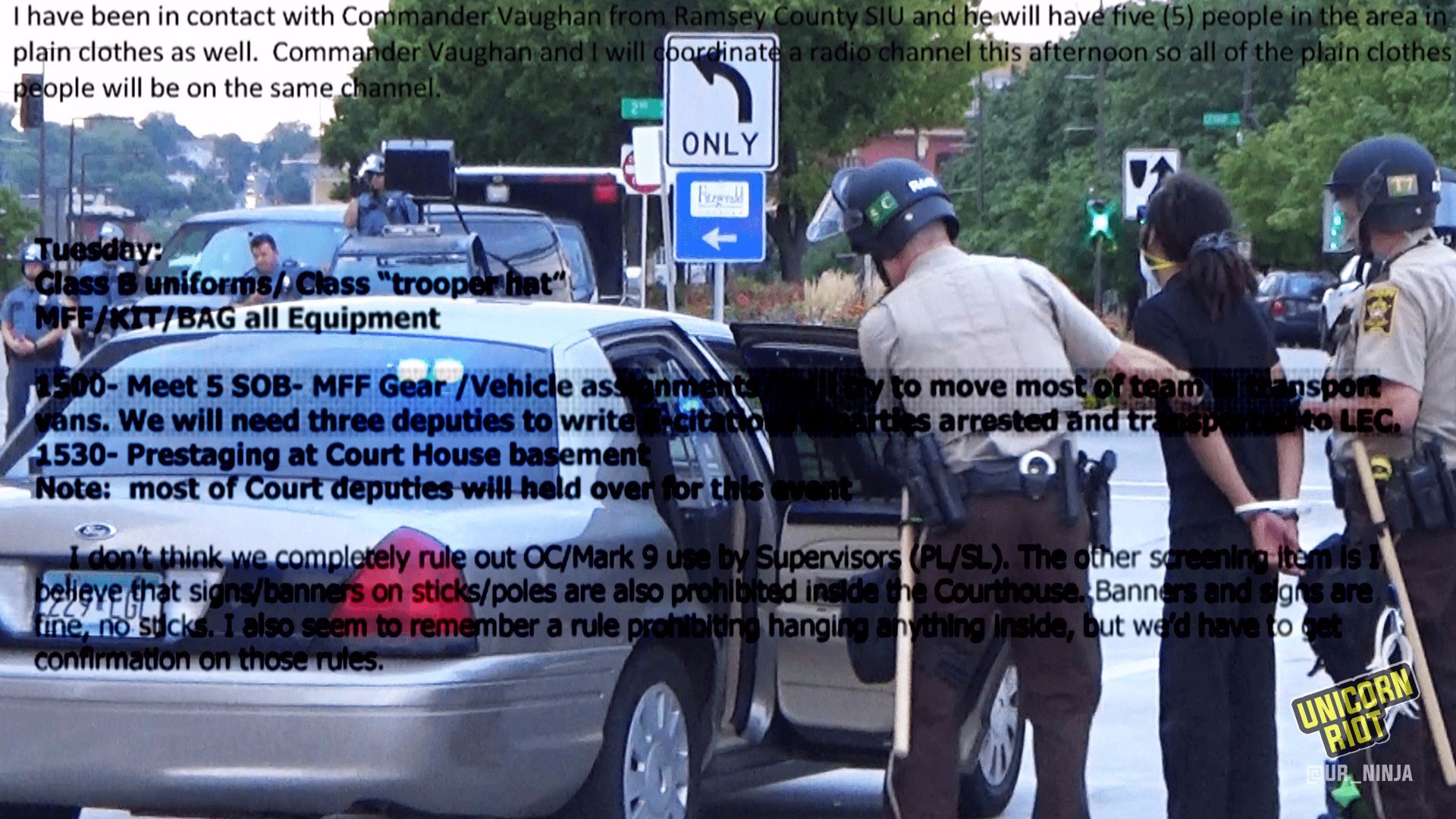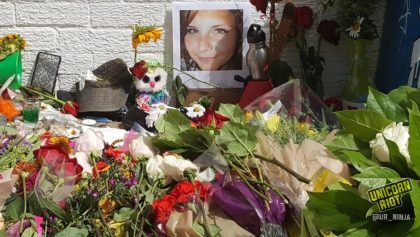Emails Show St. Paul Police Targeted Protest Organizers Seeking Justice for Philando
St. Paul, MN – Hundreds of emails and messages from St. Paul law enforcement, obtained and now released by Unicorn Riot, show that police were constantly using Facebook surveillance of protesters and interagency cooperation to target specific protest organizers involved with the 2016 ‘Justice Occupation for Philando’.
Out of 200 cases from arrests during protests after the police killing of Philando Castile, one remains open and is headed for trial on December 12, 2018. We spoke with the organizer facing an impending trial, as well as another who was recently found guilty at trial, both of whom were personally targeted and criminally charged after a protest action. [UPDATE: On December 14, Madeline Harrison, the last case left, who went on trial on December 12, was found Not Guilty of all charges.]
A mass movement seeking justice after the police shooting of Philando Castile led to the 2016 summer of discontent in the Twin Cities with dozens of protests, acts of civil disobedience, a riot on the interstate, and a three-weeks-long occupation outside the Minnesota Governor’s Residence. Since then, city prosecutors have cracked down in the courtroom, bringing misdemeanor charges to trial after authorities conducted several mass arrests of non-violent protests.
City attorneys have also targeted family of Philando Castile with felony riot charges, and charged four protest organizers by sending them citations in the mail after their participation in a heavily policed September 6, 2016 protest dubbed the ‘If We Don’t Get It Rally‘.
Documents obtained by Unicorn Riot (published below in five .PDFs) provide a closer look at how St. Paul Police handled protests, specifically the ‘If We Don’t Get It Rally’.
The ‘If We Don’t Get It Rally’ called for the indictment of former police officer Jeronimo Yanez, who shot Castile during a traffic stop near near St. Paul in July 2016. Yanez was charged two months after the rally and was found not guilty on manslaughter charges in a jury trial in June 2017. Justice Occupation for Philando (JOFP) organized the rally and created a Facebook event, which, according to the documents we obtained, was being monitored in real-time by police Special Investigations Units (SIU). JOFP is one of the handful of groups of organizers that grew from the occupation seeking justice for Castile.
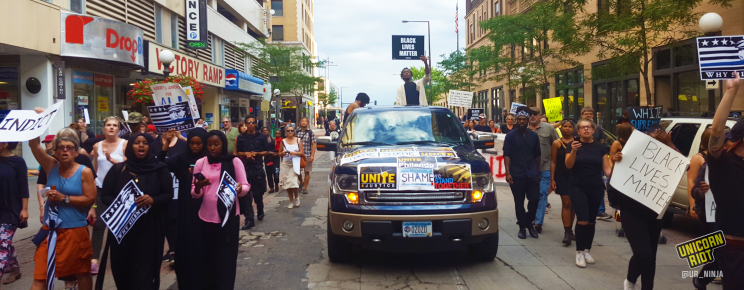
The protest started at the Saint Paul City Hall and Ramsey County Courthouse, a tall building at the edge of downtown St. Paul, and drew a spectacular amount of law enforcement attention and presence. About 150 St. Paul Police (SPPD) and Ramsey County Sheriff’s Office deputies (RCSO) sporting riot helmets, batons, and crowd control weapons followed about 200 protesters from blocks away as they snaked through downtown St. Paul streets during the Sept. 6 protest.
Emails obtained from the RCSO and SPPD show that nine plainclothes officers were deployed to the area – four from the SPPD SIU and five from the RCSO SIU (page 10 – Ramsey County JOFP).

Authorities, who didn’t know protesters’ plans beyond what was posted to Facebook, prepared Mobile Field Force (MFF) units (page 49 – Ramsey County JOFP) inside the courthouse and outside: “SPPD will have MFF ops outside of the building. We will have RCSO MFF support inside the building” (page 22 – Ramsey County JOFP).
The SPPD’s OPS Plan for the rally, obtained by Unicorn Riot, called for a Mobile Field Force (MFF) of 24 officers to respond to the rally. SPPD deployed a “Gator with LRAD“, “video recording team“, an ambulance, and three 15 passenger vans based on gathered intelligence from Facebook and no permit applied for the action.
Operations_Plan_September_06__2016_-_City_Hall_-_final_Redacted“The Saint Paul Police Department will activate a Mobile Field Force, MFF of twenty four officers. Based on the intelligence related to this event on August 31, 2016 this number should allow for a flexible response to any issues related to this event.” – Operations Plan September 06, 2016 Saint Paul City Hall
Read all of the Ramsey County emails mentioning the ‘If We Don’t Get It Rally’ between September 2 and September 19, 2016 – 140 pages (Ramsey-County-JOFP.pdf)
The police eventually surrounded and trapped the rally, threatened mass arrest, called out several protesters’ names over the loud speaker, and ultimately only arrested one of the people whose name they announced. The police then allowed people to disperse, some of whom went to nearby Rice Park and shared personal stories of police abuse. We spoke to an organizer with JOFP after the aggressive police action and summed up the rally in a video below.
NEW: Recap video of last nights #Justice4Philando action
FULL VID: https://t.co/bOKq6HW4G1 #PhilandoCastile pic.twitter.com/K758kkdW26— Unicorn Riot (@UR_Ninja) September 7, 2016
A few days after the rally, four organizers with JOFP were given misdemeanor charges through citations in the mail for participating in the Sept. 6 action.
Two of those four, Madeline Harrison and Rachael Rivard, recently spoke with Unicorn Riot about their court cases and being targeted by police.
Harrison is the last protester still fighting their charges from 2016. She has trial on December 12. Rachael Rivard was recently found guilty in her trial after fighting misdemeanor public nuisance and unlawful assembly charges and was sentenced to three days in jail, six months probation, and made to pay about $180 in court costs.
“Targeting organizers takes away their ability to continue to exercise their right to free speech, to assemble.” — Rachael Rivard
It is clear that targeting the four presumed leaders of the JOFP with criminal charges for the rally was planned by the police at the highest level by reading through the September 8, 2016 email thread with the St. Paul Police Chief Todd Axtell, the chief’s Executive Assistant Angie Steenberg and Commander Steve Frazer (who was the commanding officer during the Sept. 6 protest).
Read SPPD’s “Operations Plan September 06, 2016 Saint Paul City Hall” – 7 pages (Operations_Plan_September_06__2016_-_City_Hall_-_final_Redacted.pdf)
Read SPPD’s messages and emails regarding the “If We Don’t Get It Rally” – 21 pages (If-We-Dont-Get-It-Emails.pdf)
Read SPPD’s messages and emails regarding the “Justice Occupation for Philando” – 80 pages (JOFP-Emails.pdf)
Read emails and messages from a slew of SIUs and enforcement agents regarding protests in the days after Philando was killed – 86 pages (FOIAfromPhilandoProtests2016.pdf)
Steenberg alerted Frazer in an email about a voice message received from a Nicole Harrison regarding the arrest of Eli Lartey during the ‘If We Don’t Get It Rally’ and asked Frazer to call her back. Steenberg said that Harrison had said that she was “an advisor to the Justice Occupation Group.”
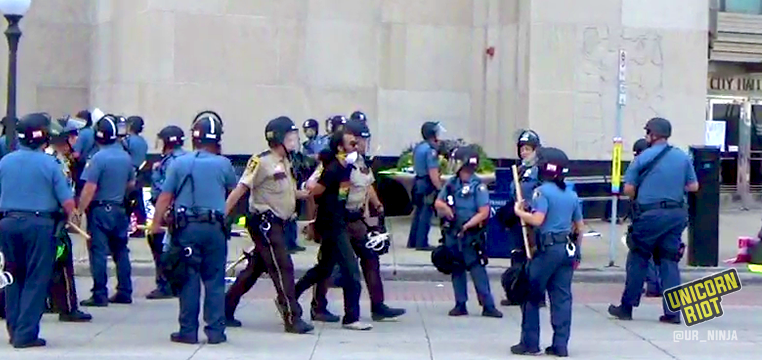
Frazer told Steenberg that he would “call her shortly,” saying “She is likely Madeline Harrison who is also in process to be arrested“, mistakenly assuming Nicole Harrison was Madeline Harrison, who was present during the protest but is not the same person, leaving it clear there was a plan beforehand to arrest leaders.
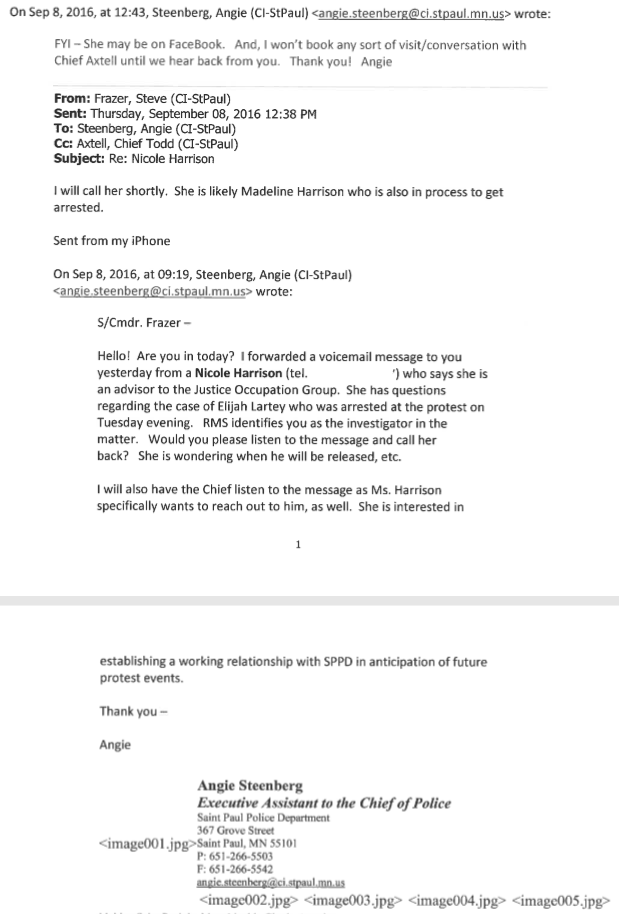
An hour before Frazer made his incorrect assumptions as to who the message was from, Axtell had thanked Frazer “for dealing with this” and said, “We may have their attention now and that can be good for us.”
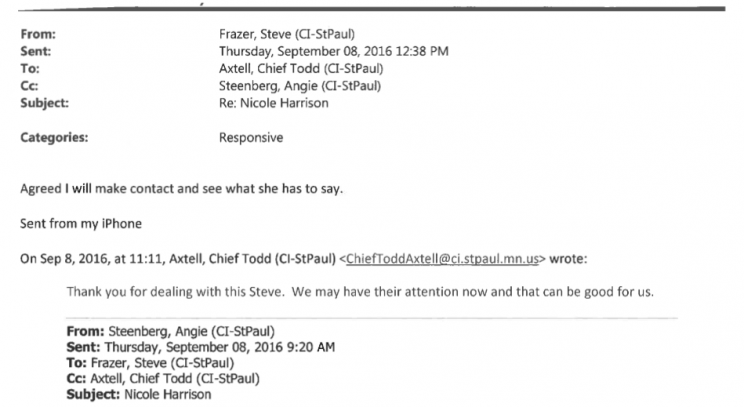
Though Harrison walked away from the action without being arrested, nine days later she received a citation in the mail announcing misdemeanor charges of public nuisance and unlawful assembly. She is set to face trial for these charges on December 12, 2018, barring further court rescheduling.
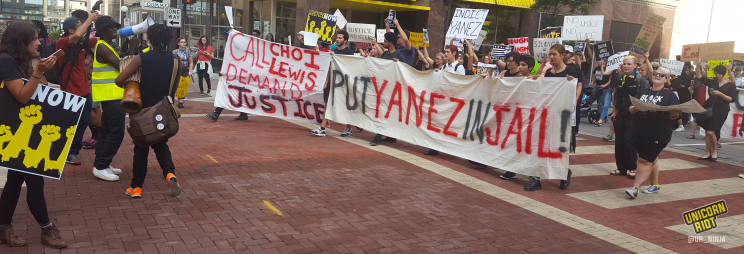
Harrison said that seeing Frazer’s email comment confirmed her suspicions that she was targeted. She furthered that she wasn’t surprised and said,
“I think that these citations were issued based on assumptions of who the police saw as organizers and to try to ‘hold us accountable’.” – Madeline Harrison
The SPPD and RCSO were getting prepared many days before the ‘If We Don’t Get It Rally’. In an email to Axtell on August 29, Assistant SPPD Chief Kathy Wuorinen wrote she was “working on a plan” with “Matt” (Matt Toupal, SPPD’s Deputy Chief of Operations) in regards to Axtell’s email detailing Facebook information gathered on the ‘If We Don’t Get It Rally’ (page 6 of If We Dont Get It Emails).
The next day, former Chief Deputy of the RCSO, Jack Serier, wrote to the then-Undersheriff of RCSO, David Metusalem, alerting him to “contact Sr. Cdr. Frazer with regard to the protest scheduled at the Courthouse next Tuesday” (page 2 of SPPD JOFP Emails).
Later, in the evening on August 30, 2016, Wuorinen sent the chief an email stating that ‘Matt’ would send an “OPS plan” and that “Steve [Frazer] is working with RCSO to identify a plan“.
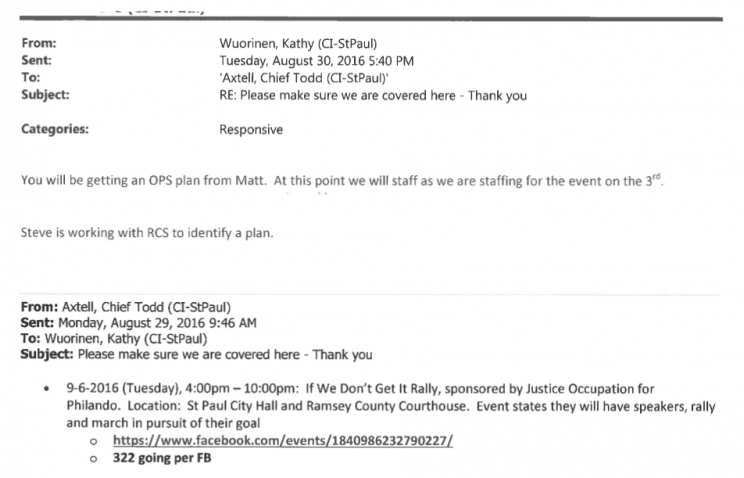
This email thread further spotlights the collaboration between the SPPD and the RCSO in over-policing non-violent protests in St. Paul. RCSO has jurisdiction over the Ramsey County Courthouse and had MFF units inside the building but also had several dozen sheriff’s deputies working with SPPD following the rally through downtown streets in transport vans wearing riot gear.
In court during protester Rachael Rivard’s trial, Frazer said that “150 police officers” were on the streets during the Sept. 6 event, which he said had about 160 protesters.
“…there were 200 people there and about 40 of them were press, he said that they had amassed 150 police officers who showed up in riot gear.” – Rachael Rivard on what Commander Frazer’s testimony during her trial
In an August 31 email from Matt Toupal to Steve Frazer and cc’d to Kathy Wuorinen, Toupal specifies that the operational plan for policing the ‘MN State #AintFair‘ rally on Saturday and the Tuesday night ‘If We Don’t Get It Rally‘ was due by that Friday morning, September 2, 2016.
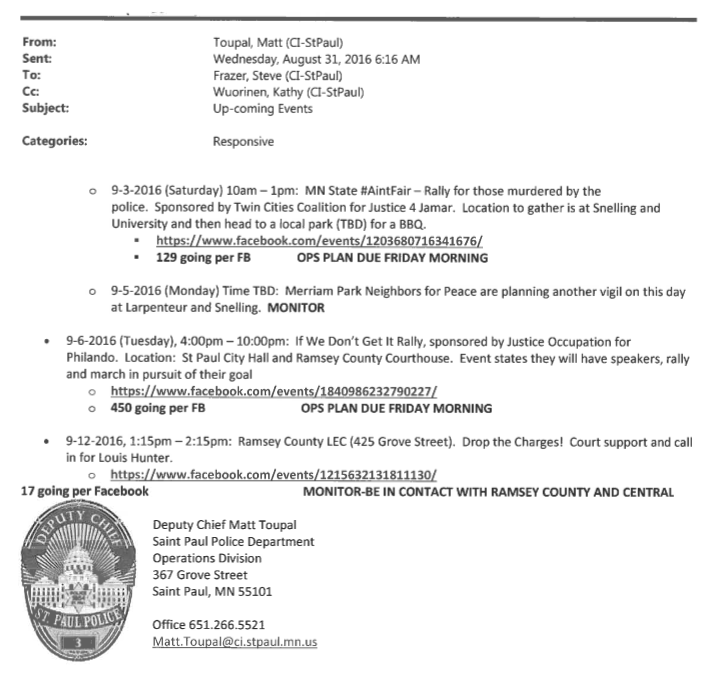
We asked the Ramsey County Sheriff’s Office for the operational plan and they rejected our request, saying their office “considers operational plans to be protected nonpublic material pursuant to Minnesota Statute § 13.37 and not subject to public release.”
Read St. Paul Police Department’s “Operations Plan September 06, 2016 Saint Paul City Hall” – 7 pages (Operations_Plan_September_06__2016_-_City_Hall_-_final_Redacted.pdf)
On September 1, 2016, Commander Sheila Larson sent an email to three SPPD officers calling for riot helmets, gas masks, and uniforms to be ready.
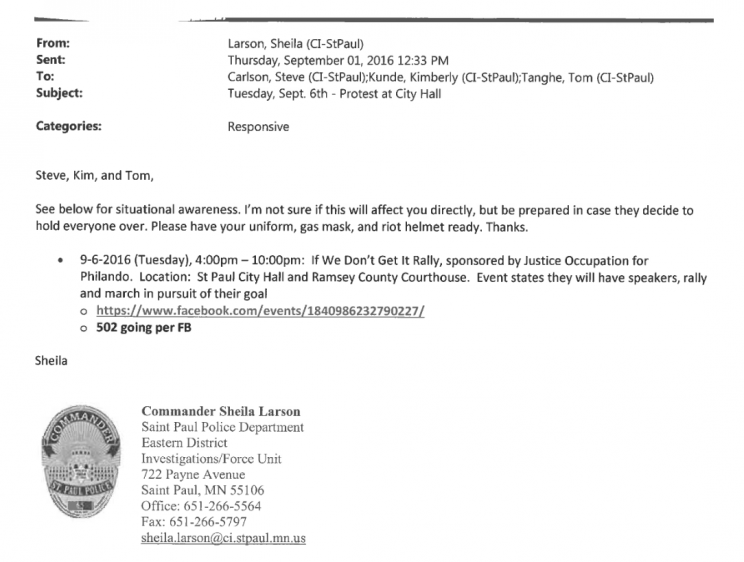
Showing real-time surveillance of Facebook, on the day of the action, SPPD Commander David Mathison sent an email update at 8:59 a.m. to several high-ranking officers to remind them about the “Rally at Courthouse“. Mathison also gave updates they found on the Facebook event page (page 5 of SPPD JOFP Emails).
Unicorn Riot was live during the whole rally and observed the aggressive police tactics. Below, one can see a portion from our livestream coverage showing moments before the die-in until moments after the kettle and the one arrest that was made (at the bottom of the page is the full stream).
Read the documents [pdf] gathered from a request to the St. Paul Police Department for messages and emails regarding the “If We Don’t Get It Rally“:
If We Dont Get It Emails
Read the documents [pdf] gathered from a request to the St. Paul Police Department for messages and emails regarding the “Justice Occupation for Philando“:
SPPD-JOFP
Read emails and messages from a slew of SIUs and enforcement agents regarding protests in the days after Philando was killed – 86 pages (FOIAfromPhilandoProtests2016.pdf).
Read Ramsey County emails mentioning the ‘If We Don’t Get It Rally’ between September 2 and September 19, 2016 – 140 pages (Ramsey-County-JOFP.pdf)
Read St. Paul Police Department’s “Operations Plan September 06, 2016 Saint Paul City Hall” – 7 pages (Operations_Plan_September_06__2016_-_City_Hall_-_final_Redacted.pdf)
Rachael Rivard said she originally found out she had been charged from participating in the protest action by her neighbor who “mentioned that he was proud of the work that I was doing, after seeing my name in the Pioneer Press.”
She received her citation in the mail on September 14 along with three others from JOFP; Harrison, Jacob Thomas, and Curtis Avent (who also had his name called over the loudspeaker by police), received their citations a day later.
The officer in charge from SPPD was Cmdr. Steve Frazer. Rivard said that during her trial, “Frazer actually said that the reason they didn’t arrest us on site was because they felt that to make more arrests would have made the situation violent. It’s total BS, they have arrested mass amounts of people before with no incident.”
Rivard said that “Curtis and I left after they threatened mass arrest, hand and hand and they [the police] didn’t stop us” although Avent’s name was called out. Avent was later hit with with an additional charge of fleeing the police because he walked away from the protest that night.
Rivard wondered what she did that was different from others in the street, and why the four of them were targeted. She alluded to Frazer telling her that he had “recognized” her from other Philando Castile protests.
The Negativity of Court & The Positivity of Court Support
The process of these court cases is massively taxing emotionally and financially on those facing charges, on top of the psychological reality of reliving what many say were traumatic arrests. It’s a process even more challenging for young people of color who faced charges, said Harrison, who stated the risk was higher had they been “found guilty of all charges.”
Harrison said those factors led many people to be “forced and coerced into taking plea deals” which called for hundreds of dollars in fines, “as well as effectively removing the ability of many to protest.”
“Plea deals changed over the course of the last two years, but usually ranged from paying $100 [to] $350, and 6 months to a year of probation with no same or similar. Essentially these plea deals made people pay hundreds of dollars for being brutally arrested for practicing their First Amendment rights, as well as effectively removing the ability of many to protest because if they were arrested again at a protest before their probation period was up they could face jail time.” – Madeline Harrison
Rivard said they had been to court seven times before their trial, and that each time she needed “to take PTO from work to show up and sit in a court room until our cases were called, at that point they would schedule another date, over and over.”
“I wouldn’t say it falls in what I would expect with a right to a speedy trial.” – Rachael Rivard
Attorney Jordan Kushner, who has represented many arrested during Philando Castile protests, blamed judges for delays in the court process and said that “having to go through a drawn out court process probably will discourage some people from protesting.” Yet, Kushner said there are further effects in which “the continued political networking as a result of the court process could strengthen some people’s involvement.”
“At the end of the day many of us will not see justice. Philando did not get justice. We continued this fight in the courtroom because it was an extension of fighting for justice for Philando.” – Madeline Harrison
Transportation to and from court dates was arranged; strategies were hatched to demand charges be dropped. People showed up at each other’s court dates and supporters showed up as well. Harrison said at times the defendants “spoke almost daily to each other.”
A sad side story important to the arrestees was the passing of educator Jeffrey Ayer earlier in 2018. Ayer had became heavily involved in aspects of the justice for Philando movement and was steadfast in his efforts to not accept a plea deal from his arrest at the Governor’s Residence up until his untimely death.
After the summer of unrest following Philando Castile’s death, there were different groups of arrestees with cases stemming from dozens of protest actions and several mass arrests. Those groups collaborated together to provide a larger network of support. Harrison said, earlier in the process “folks from the Mansion Arrests, from the 94 arrests, and the Louis Hunter support folks … would have semi-frequent ‘inter-arrestee’ meetings where we would work on strategies and discuss how we all could best support the needs of the different groups of arrestees.”
Louis Hunter, Philando Castile’s cousin, bore the brunt of a more than year-long process battling multiple trumped-up felony riot charges for being on Interstate 94 when over twenty police officers were injured in several hours of clashes with militant protesters. Louis was the only one of the hundreds present who faced felonies.
A large international network of people from anarchists to criminal defense lawyers supported Louis Hunter. Hunter’s charges were dropped days before his trial, and a week after an action brought over 1,000 signatures to the Ramsey County Attorney’s Office calling on County Attorney John Choi to drop the charges. Hunter has since opened up Trio Plant-based, a vegan restaurant in Minneapolis, along with Sarah and Dan Woodcock.
After the action for Louis Hunter in the fall of 2017, we spoke to Jesse Mortenson, who was one of dozens of community members facing third degree riot and a litany of misdemeanor charges stemming from their involvement in the protest on Interstate 94. He spoke about how dozens had banded together and refused to take plea deals until Louis Hunter’s charges were dropped.
All of the court support and solidarity was done for the most part without the support of any single large organization, and mostly with volunteer attorneys familiar to the movement who “donated their time and hard work over the years“, said Harrison.
“Having movement-conscious attorneys can help make the best out of the situation, and can obviously provide more effective representation than people representing themselves or attorneys who are indifferent to the cause.” – Attorney Jordan Kushner
Seventeen people had their charges dropped this fall, and even when Madeline’s two-year-long misdemeanor case, the last of the 200 Philando Castile protests cases, is over in the courtroom, the bonds of solidarity between those who risked jail time for Philando will continue for a lifetime for some.
Watch our livestream coverage from the ‘If We Don’t Get It Rally’:
A movement popularized by the Facebook live video of Philando Castile dying after being shot by police would quickly blossom into the real-time Facebook surveillance of those seeking justice for Castile, heavy-handed police responses to protests, and the targeting of perceived leaders. Below, read and/or download 327 pages of documents from the SPPD and RCSO about policing the protests.
- Saint Paul Police Department’s 7-page “Operations Plan September 06, 2016 Saint Paul City Hall” [pdf]
- Ramsey County emails mentioning the ‘If We Don’t Get It Rally’ between September 2 and September 19, 2016 – 140 pages [pdf]
- Saint Paul Police Department’s messages and emails regarding the “If We Don’t Get It Rally” – 21 pages [pdf]
- Saint Paul Police Department’s messages and emails regarding the “Justice Occupation for Philando” – 80 pages [pdf]
- Messages and emails from a slew of special investigation units and enforcement agents regarding protests in the days after Philando was killed – 86 pages [pdf]
Please consider a tax-deductible donation to help sustain our horizontally-organized, non-profit media organization:

Unicorn Riot coverage of Philando Castile's Killing by St. Anthony Police Officer Jeronimo Yanez:
- St. Anthony Police Murder Philando Castile for Reaching for his License - July 7, 2016
- Vigil for Philando Castile Brings Over 4k People – 2nd Night of Occupying Governor’s Mansion - July 8, 2016
- Protesters Blockade Interstate 94, 100+ Arrests, 20+ Cops Injured - July 9, 2016
- Justice for Philando Castile Allies Blockade I-35W Bridge - July 13, 2016
- Twin Cities Anarchist People of Color Engage Militancy Debate - July 13, 2016
- Twin Cities Community Sends Message that MN State #AintFair - September 3, 2016
- County Atty Choi Charges Officer Yanez in Shooting of Philando Castile - November 16, 2016
- No Verdict Yet In Trial of Officer Yanez for Philando Castile Murder - June 14, 2017
- Still No Verdict In Trial Of Officer Jeronimo Yanez For Philando Castile Shooting - June 15, 2017
- Officer Yanez Found Not Guilty In Trial Over Philando Castile Police Killing - June 16, 2017
- Action to ‘Drop the Charges’ on Louis Hunter - July 28, 2017
- Philando Castile’s Cousin Has Felony Riot Charges Dropped After Community Outcry - August 2, 2017
- Families of Police Victims Create Community Amidst Tragedy - March 22, 2018
- Bulletproof Warrior Training Manual Released - May 25, 2018
- Police Improperly Released Armed Men Who Antagonized Philando Castile Protest - October 22, 2018
- Emails Show St. Paul Police Targeted Protest Organizers Seeking Justice for Philando - December 10, 2018
- Vigil Marks Three Years Since Police Killed Philando Castile - July 9, 2019
- Philando Castile Remembered Six Years After Being Killed by Police - August 1, 2022
